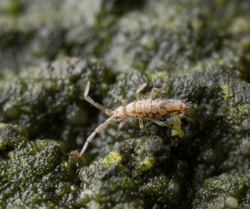Spring – the season of rejuvenation and new beginnings. But along with blooming flowers and fresh breezes, it often brings an unwelcome guest: springtails. These tiny, nuisance pests can quickly turn your peaceful abode into a battleground as they seemingly appear out of nowhere, infesting damp corners and dark crevices. If you're tired of their persistent presence and seeking effective ways to bid farewell to these bothersome creatures, you've come to the right place.
What are springtails?
Springtails, scientifically known as Collembola, are tiny, wingless arthropods that belong to the class Hexapoda. Despite their small size, ranging from 0.25 to 6 millimeters in length, springtails play an essential role in the ecosystem as decomposers. These creatures derive their name from a unique appendage called a furcula – a fork-like structure located on the abdomen. The furcula acts as a spring, allowing springtails to propel themselves into the air when threatened or disturbed.
In terms of appearance, springtails can vary in color, with shades of white, gray, black, or metallic hues. Their bodies are soft and elongated, usually segmented into three distinct parts: the head, thorax, and abdomen. They have six legs, each equipped with a tiny claw-like structure. Another notable feature is their antennae, which are sensitive and help them navigate their surroundings.
Biologically, springtails thrive in moist environments such as soil, leaf litter, and decaying organic matter. They have a simple life cycle, undergoing incomplete metamorphosis. This means they hatch from eggs into nymphs, resembling miniature adults, and gradually grow through a series of molts. Springtails possess the ability to reproduce rapidly under favorable conditions, resulting in large populations in a short span of time.
When it comes to behavior, springtails are highly adaptive and resilient. They are most active in humid conditions, and their populations tend to surge during spring and fall. Springtails are primarily detritivores, feeding on decaying plant material, fungi, algae, and bacteria. They play a crucial role in nutrient cycling, breaking down organic matter and releasing essential elements back into the ecosystem. Springtails are attracted to moisture-rich areas and can be found in bathrooms, basements, kitchens, potted plants, and damp outdoor spaces. Their presence often indicates underlying moisture or mold issues. As highly mobile creatures, springtails can disperse through crawling or jumping, aided by their impressive jumping abilities.
Understanding the appearance, biology, and behavior of springtails lays the foundation for effective pest control strategies. With this knowledge, you can now embark on the journey of eliminating these pesky intruders from your living spaces.
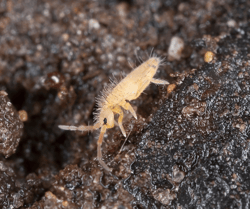
Why are springtails a problem for homeowners?
While springtails provide an essential service to our ecosystem as natural decomposers, they can be troublesome for homeowners. In fact, springtails can pose several problems for homeowners, making their presence an unwelcome nuisance. Here are some reasons why springtails can be problematic:
- Indoor Infestations: Springtails are known to invade homes, especially in areas with high moisture levels. They can enter through cracks, gaps, or open windows and doors, quickly establishing populations indoors. Finding large numbers of springtails crawling across floors, walls, or countertops can be inconvenient… and gross!
- Unsightly Presence: While springtails themselves do not cause direct harm to humans or property, their sheer numbers and constant movement can be visually disturbing. Their small size and ability to jump make them difficult to ignore, causing annoyance and discomfort for homeowners. Some homeowners report that it feels like their home is crawling around them!
- Moisture Issues: Springtails thrive in damp environments. Their presence in homes often indicates underlying moisture problems such as leaky pipes, plumbing issues, or excessive humidity. These conditions can lead to mold growth, wood rot, or structural damage if left unaddressed.
- Allergies and Asthma Triggers: Some individuals may experience allergic reactions or asthma exacerbation in the presence of springtails. While it's uncommon, their shed skins or fecal matter may act as triggers for certain sensitized individuals, causing respiratory symptoms and discomfort.
- Garden and Plant Damage: In outdoor spaces, springtails can damage plants and gardens. They feed on the roots, stems, and leaves of various plants, potentially leading to stunted growth, discoloration, or plant decline. This can be frustrating for garden enthusiasts and homeowners with landscaped yards.
- Difficult to Eradicate: Springtails can be challenging to eliminate completely without addressing the underlying moisture issues. Their ability to reproduce rapidly and adapt to different conditions makes it crucial to employ comprehensive pest control strategies to ensure long-term success.
By understanding the problems associated with springtails, homeowners can take proactive steps to prevent infestations, address moisture-related issues, and implement effective pest management techniques.
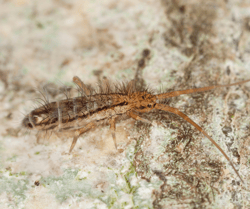 Springtail on a kitchen countertop.
Springtail on a kitchen countertop.
Can I prevent springtails in my home or yard?
Absolutely! There are several preventive measures you can take to minimize the presence of springtails in your home and yard. Here are some effective strategies:
- Moisture Control: Springtails thrive in damp environments, so reducing excess moisture is crucial. Fix any plumbing leaks, ensure proper drainage around your home, and address areas with high humidity, such as bathrooms or basements. Use dehumidifiers, if necessary, to maintain optimal moisture levels.
- Ventilation: Proper airflow helps to prevent stagnant and humid conditions that attract springtails. Ensure adequate ventilation in bathrooms, kitchens, and other moisture-prone areas. Use exhaust fans or open windows to promote air circulation.
- Seal Entry Points: Seal cracks, gaps, and openings in doors, windows, and foundation walls to prevent springtails from entering your home. Pay attention to areas where pipes and utility lines enter the house as well.
- Remove Organic Debris: Springtails feed on decaying organic matter, so it's important to remove leaf litter, mulch, grass clippings, and other debris from your yard. This reduces their potential food sources and breeding grounds.
- Proper Landscaping: Maintain a well-groomed yard with regular mowing, pruning, and trimming. Keep plants and shrubs away from the foundation of your home to prevent springtails from accessing the structure.
- Dry Out Wet Areas: Address any areas in your yard that tend to retain excessive moisture, such as low-lying spots or poorly drained areas. Improve drainage, add gravel, or use landscaping techniques to promote proper water flow and prevent water accumulation.
- Avoid Overwatering: Be mindful of watering practices for your indoor and outdoor plants. Overwatering can create overly moist conditions that attract springtails. Water plants as needed, allowing the soil to dry out between waterings.
- Regular Cleaning: Regularly clean and declutter your home, paying attention to areas prone to moisture and organic debris buildup. Vacuum and sweep floors, wipe down countertops, and remove any food or water spills promptly.
By implementing these preventive measures, you can significantly reduce the likelihood of springtail infestations in your home and maintain a more pest-free environment.
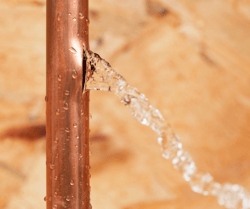 Fix any leaky plumbing to avoid moisture-dependent springtails.
Fix any leaky plumbing to avoid moisture-dependent springtails.
What should I do if I have a springtail infestation?
If you have an infestation of springtails, don’t panic! There are several steps you can take to address the issue:
- Identify the Source: Conduct a thorough inspection to identify the source of the infestation. Look for areas with high moisture, such as leaky pipes, damp basements, or areas with poor ventilation. Springtails are attracted to moisture-rich environments, so addressing the underlying cause is crucial.
- Reduce Moisture: Eliminate excess moisture in and around your home. Fix any leaks, improve drainage, and ensure proper ventilation in moisture-prone areas. Use dehumidifiers or fans to reduce humidity levels. By reducing moisture, you make your environment less attractive to springtails.
- Remove Clutter: Clear clutter from your home and yard, as springtails are attracted to decaying organic matter. Remove leaf litter, grass clippings, and other debris from your yard. Inside your home, declutter and clean areas where springtails are present.
- Vacuuming: Use a vacuum cleaner with a hose attachment to remove springtails from floors, walls, and other surfaces. Focus on areas where springtails are concentrated. Empty the vacuum bag or canister promptly to prevent springtails from escaping.
- Sealing Entry Points: Seal cracks, gaps, and openings in doors, windows, and foundation walls to prevent springtails from entering your home. Pay attention to areas where pipes and utility lines enter the house as well.
- Professional Help: If the infestation persists or becomes overwhelming, it may be best to seek assistance from a trusted pest control professional like EcoShield. Our expert pest technicians have the knowledge, experience, and resources to effectively assist homeowners with pest infestations.
Remember, prevention is key in managing springtail infestations. By addressing moisture issues, practicing good sanitation, and implementing preventive measures, you can significantly reduce the chances of future infestations.
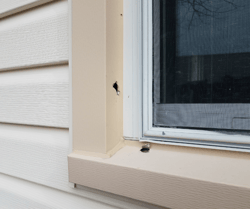 Seal cracks, gaps, and openings in doors, windows, and foundation walls to prevent springtails from entering your home.
Seal cracks, gaps, and openings in doors, windows, and foundation walls to prevent springtails from entering your home.
Can EcoShield help me prevent springtails?
Yes!
At EcoShield, we believe prevention is the best frontline defense against pests. With our Shield Home Protection Plan, we offer continuous protection against a multitude of pests. EcoShield’s thorough inspection, initial service, and maintenance services provide the comprehensive protection against pests that homeowners need to stay pest-free year round! Call EcoShield today or fill out the form on this page for your free no obligation quote.
